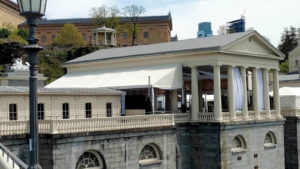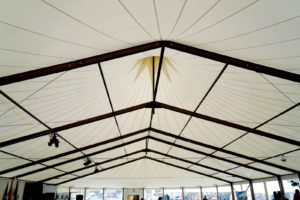
and installed by L & A Tent Rentals. Photo courtesy of L & A Tent Rentals.
The difference between coated versus laminated PVC and features such as durability, weight, strength, cleanability and the end product all factor into making the best investment.
A tent without fabric wouldn’t be a tent. And yet, according to fabric manufacturers, there’s a widespread lack of knowledge about this fundamental component of the tent rental business.
“There are essentially two types of tent material: PVC-coated polyester mesh and PVC-laminated polyester mesh. Canvas and cotton are still used, but not often,” says Linc Aldershof, North American sales manager, tent division of Verseidag US in Randolph, N.J. “Coated tent material is typically more costly, but will last longer and is easier to weld and clean, as long as the material is topcoated with an acrylic lacquer finish.”
He explains the distinction between the two processes in terms of a sandwich: “When you spread mayonnaise, it coats the entire bread. When you put a piece of baloney on it, it’s only lying on the bread. When you coat PVC, it’s a paste. Laminate is like laying baloney over it; parts of the bread don’t get touched.”
Verseidag manufactures only coated fabric for tents but does sell one laminated product in two weights. Aldershof says coated fabric makes a nicer-looking tent.
“It is certainly a better performer than a laminate in most large tent or structure applications,” he says. “It is heavier and, consequently, stronger. The upside with laminates is that they are inexpensive and work well for smaller tents.”
Laminates come in lighter weights and are more than adequate for a range of tents from 10-by-10-feet up to 40-feet wide, he says. In that size range, cost comes into play, especially for companies in regions where tent demand is highly seasonal. “It’s hard for any small business to put money on the shelf for anywhere from four to six months of the year,” he says.

To Jeff Sparks, business unit manager for tent, structure and custom fabrics for Herculite® Inc. of Emigsville, Pa., there’s not a lot of difference between coated and laminated vinyl.
“They are both PVC fabrics with polyester substrates, but are made with different processes,” he says. “Each has advantages and disadvantages over the other. Most coated fabrics in the tent market are typically made heavier and with stronger substrates. But composite laminated fabrics can be made with the same tensile strength and actually even higher tear strengths than coated fabrics.”
Because coated fabrics for the tent industry are heavier, they can have better abrasion resistance, Sparks says.
“But, again, a laminated fabric can be made with the same amount of PVC to make them apples to apples for comparison,” he says. “Most laminated tent fabrics in the United States are in the 14- to 18-ounce range, whereas coated fabrics are 18 to 24 ounces.”
Sparks adds that coated fabrics perform better than laminates in extreme cold temperatures.
Durable goods
“Every tent has a lifespan. The most important thing is to understand proper storage, care and use for the fabrics,” says Joseph Palmer, sales manager for DAF Products Inc. in Wyckoff, N.J. “While tent fabrics are built to be durable, they can still become damaged if mishandled. Two guidelines are (1) follow the tent manufacturer’s instructions for washing, storage and installation and (2) avoid, or at least be careful with, chemicals and heat during washing and storage.” (See “Glisten and gleam,” page 32.)
Laminated vinyl is strong, durable and offers a wide range of options for width, embossing and weight, Palmer says.
“It traditionally offers a better cost for the quality,” he says. “Coated material offers improved strength and durability, but is more limited in width, embossing and weight and can be more expensive for the quality.”
John Kardos, sales representative for Snyder Manufacturing in Dover, Ohio, agrees that protecting fabric plays a crucial role in its life. Durability is affected by the care taken when setting up and striking a tent, he says. When rental companies follow the manufacturer’s care instructions, tent fabric should last a very long time.
“Strength is a factor of the construction of the tent and scrim used to reinforce the fabric,” he says. “Heavier yarn is obviously stronger than lighter yarn, but a woven scrim is stronger than a knit scrim on an equal weight basis. Coated materials are more durable given the same weight, are more resistant to pinholes and do not have as many problems with moisture wicking, but they are a lot more expensive.”
In addition to knowing the tear and tensile strength of fabrics, Sparks says, tent rental companies need to understand that not all tent fabrics are created equal.
“The formulas that manufacturers use can vary with UV stabilization, antimicrobial resistance, flame-retardant properties and abrasion and pinhole resistance.”
Rob Jones, eastern regional sales manager for ABC Industries, says that his company uses a large variety of PVC films, working with both extrusion and calendering-based suppliers. The Warsaw, Ind.-based company supplies only laminated fabrics.
“Tent manufacturers drive the specifications,” he says. “For example, a manufacturer wanting a higher-quality tent will want a heavier fabric with greater abrasion resistance. We enhance the wearability by using a thicker film on the face side.”
Jones points to three considerations related to fabric durability: trapezoidal tear strength, grab/tensile strength and puncture resistance—all of which are tested in ABC’s in-house lab. Fabric-quality needs depend on the user.
“Inexpensive tents call for lightweight and lower-quality fabrics. High-quality tents demand high-quality materials that perform well over a longer period of time,” Jones says.

Weighing the options
When should a tent rental company invest in a more expensive fabric? Consider the size and style of the tent and the end-user market.
“Once tent rental companies get into 60-foot-wide tents, they really need to be moving to coated materials. In order to get our foot in the door, Verseidag developed a laminate 100 inches wide,” Aldershof says, adding that 97 percent of his company’s sales are coated fabrics from its manufacturing base in Krefeld, Germany.
“I think the biggest concern for material comes from the structure companies,” he says. “They demand the best in durability, cleaning and longevity. Most companies buying rental tents care mostly about expense and matching inventory.”
Rental companies that handle high-end events in larger cities are probably the most concerned with a tent’s fabric, Sparks says. “They look for fabrics that will last and not have light pinholes or collect dirt easily,” he adds.
All rental companies, however, need a fabric that is strong enough for the engineering and size of the tent.
In addition to durability and ease of cleaning, UV stability and mildew resistance are factors that tent rental companies should weigh in their purchasing decisions, Kardos says. Those that do custom fabrication also need to consider the ability of the fabric to be heat- or induction-welded and the reputation of the fabric supplier.
“UV resistance is important for protecting the integrity of the PVC film,” he says. “But care must be taken to have colorants that are UV stable as well. The PVC can be well protected from UV degradation but have problems if the colorants are also not UV stable.”
If a tent is put away wet, even if its fabric is treated with a fungicide, mildew will occur on the surface.
“And if the yarn in the fabric is not low wicking, there may be an issue with mildew traveling through and showing dark lines. This will not be removed by any amount of washing,” Kardos warns.
Mildew grows on anything—even the best-quality PVC, whether it is coated or laminated, Aldershof says.
“Mildew inhibitors are put into most quality materials, but tents still need to be clean and dry when stored,” he says. “Plasticizers eventually leach out of all PVC, making them harder to clean and very brittle. UV rays are the number one aging culprit.”
ABC Industries performs accelerated weathering tests to compare fabrics. But initially, Jones says, tent makers and rental companies should ask whether a fabric has UV and color stabilization and then what that means, because quantitative levels are vague unless they have comparative testing.
It’s critical for fabric in the tent rental industry to include resistance to mildew, moisture, flame and UV rays. Most fabrics built for the industry include all of these, Palmer says.
“But different environments may give different results,” he says. “A fabric may start to show signs of aging faster in the hot desert sun of Arizona than in a protected field in Minnesota. The level of protection can be customized, depending on customer needs.”
Janice Kleinschmidt is a freelance writer based in San Diego, Calif.
Jeff Sparks, Herculite:
- Pinhole resistance in blockout fabrics
- Mildew resistance
- UV resistance
John Kardos, Snyder Manufacturing:
- Durability
- Ability to clean
- Understanding the difference in tent designs and knowing which fabrics work best for each
Linc Aldershof, Verseidag US:
For tent rental companies purchasing tents:
- Life
- Ability to clean
- Durability
For tent rental companies manufacturing tents:
- Weldability
- Ability to clean
- Life
What’s trending in tent fabrics and coatings? Here’s what the representatives of some fabric manufacturers have to say:
“It seems there has been interest in much lighter fabrics, but [tent rental companies] don’t want to give up any strength,” says Rob Jones of ABC Industries. “We have noticed there has been a movement to sailcloth, lightweight nylon. Lighter-weight fabrics have reduced field life. Nylon suffers from poor cleanability. Fabric that is fire retardant is always at the forefront.”
Joseph Palmer of DAF Products Inc. says that his company is seeing more requests for wider-width materials. “The biggest reason is to reduce seams, which can reduce labor costs and improve visual appeal,” he says. “Another growing trend is clear vinyl windows.”
Jeff Sparks of Herculite mentions new fabric styles that look more like a fabric than a traditional glossy vinyl, offering a niche for high-end events.
“Also, topcoats are becoming less expensive and can offer better cleanability and help extend the life of the fabric,” he says. “Usually, more long-term, fixed applications use topcoats, but with lower costs, it can add value to higher-end tent fabrics.”
Linc Aldershof of Verseidag US says that the best is yet to come. “The PVC industry has not really made advances that end users would appreciate beyond flexibility and cleanability,” he says. “The best tent material has not yet been developed. Until then, coated PVC for larger tents and structures and laminates for smaller tents will be the best options.”
 TEXTILES.ORG
TEXTILES.ORG


